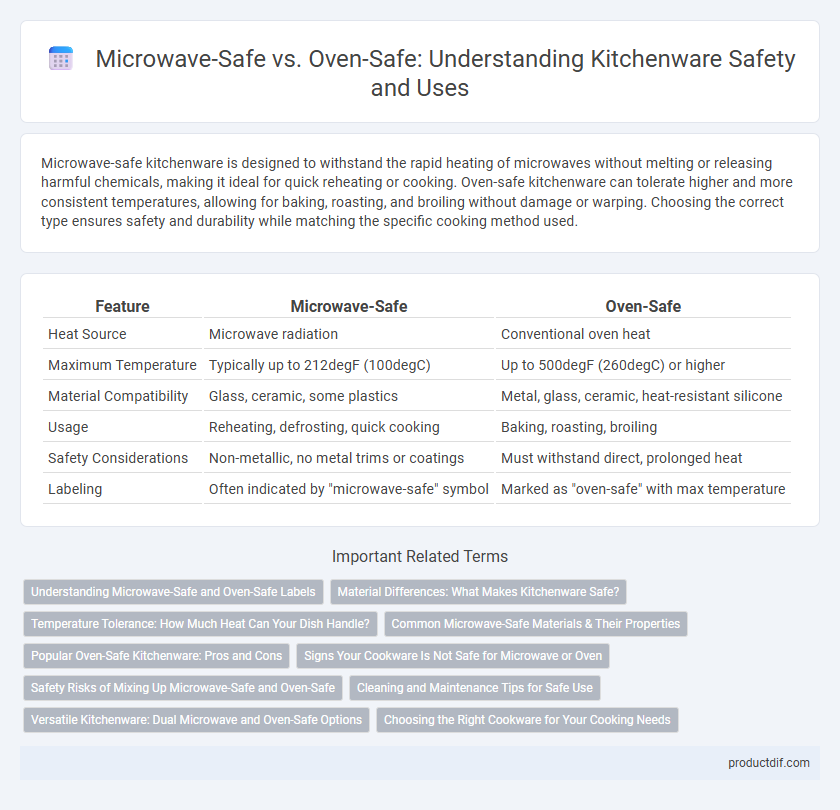Microwave-safe kitchenware is designed to withstand the rapid heating of microwaves without melting or releasing harmful chemicals, making it ideal for quick reheating or cooking. Oven-safe kitchenware can tolerate higher and more consistent temperatures, allowing for baking, roasting, and broiling without damage or warping. Choosing the correct type ensures safety and durability while matching the specific cooking method used.
Table of Comparison
| Feature | Microwave-Safe | Oven-Safe |
|---|---|---|
| Heat Source | Microwave radiation | Conventional oven heat |
| Maximum Temperature | Typically up to 212degF (100degC) | Up to 500degF (260degC) or higher |
| Material Compatibility | Glass, ceramic, some plastics | Metal, glass, ceramic, heat-resistant silicone |
| Usage | Reheating, defrosting, quick cooking | Baking, roasting, broiling |
| Safety Considerations | Non-metallic, no metal trims or coatings | Must withstand direct, prolonged heat |
| Labeling | Often indicated by "microwave-safe" symbol | Marked as "oven-safe" with max temperature |
Understanding Microwave-Safe and Oven-Safe Labels
Microwave-safe labels indicate materials designed to withstand microwave radiation without melting, releasing harmful chemicals, or causing sparks, typically including glass, ceramic, and certain plastics. Oven-safe labels signify cookware that can endure high temperatures in conventional ovens, often made from metal, tempered glass, or heat-resistant ceramics. Understanding these labels helps prevent damage to kitchenware and ensures safe food preparation by selecting appropriate containers for microwave heating or oven cooking.
Material Differences: What Makes Kitchenware Safe?
Microwave-safe kitchenware is typically made from materials like glass, ceramic, and certain plastics that do not contain metal or release harmful chemicals when exposed to microwave radiation. Oven-safe items are crafted from durable materials such as tempered glass, cast iron, stainless steel, and specific ceramics that can withstand high, consistent heat without warping or cracking. The key difference lies in heat tolerance and radiation interaction; microwave-safe materials allow microwave energy to pass through and heat food evenly, while oven-safe materials endure prolonged exposure to dry, intense heat.
Temperature Tolerance: How Much Heat Can Your Dish Handle?
Microwave-safe kitchenware typically withstands temperatures up to 212degF (100degC), suitable for reheating or cooking without melting or warping, while oven-safe dishes endure much higher temperatures, often up to 500degF (260degC) or more, allowing for baking and roasting. Glass, ceramic, and metal cookware labeled oven-safe maintain structural integrity and heat resistance at elevated temperatures, whereas microwave-safe plastics must avoid exceeding lower thermal thresholds to prevent toxic chemical release. Understanding temperature tolerance ensures safe usage and preserves dish longevity, preventing damage from heat exposure beyond recommended limits.
Common Microwave-Safe Materials & Their Properties
Common microwave-safe materials include glass, ceramic, and specific plastics designed to withstand microwave radiation without melting or leaching chemicals. Glass and ceramic offer excellent heat retention and even heat distribution, making them ideal for reheating and cooking in microwaves. Microwave-safe plastics are typically BPA-free and resistant to warping, ensuring safety and durability during repeated microwave use.
Popular Oven-Safe Kitchenware: Pros and Cons
Popular oven-safe kitchenware such as cast iron skillets, ceramic bakeware, and glass dishes offer excellent heat retention and versatility for baking, roasting, and broiling. Cast iron provides superior durability and evenly distributed heat but requires regular seasoning to prevent rust, while ceramic cookware delivers even cooking and aesthetic appeal but can crack under sudden temperature changes. Glass bakeware is non-reactive and easy to clean, though it may be less durable and prone to breakage compared to metal alternatives.
Signs Your Cookware Is Not Safe for Microwave or Oven
Cookware that is not microwave-safe often contains metallic elements or has decorative metallic trims, which can cause sparks and damage the appliance. Oven-unsafe cookware typically has plastic handles or non-heat-resistant coatings that may melt or release harmful fumes under high temperatures. Labels such as "Not for microwave use" or "Hand wash only" indicate the cookware's limitations and signal potential safety hazards when used improperly.
Safety Risks of Mixing Up Microwave-Safe and Oven-Safe
Using microwave-safe cookware in a conventional oven can cause melting or warping due to high temperatures exceeding the material's limit, leading to potential fire hazards. Conversely, oven-safe items may contain metals that are unsafe for microwave use, risking sparks and damage to the appliance. Confusing these types increases safety risks such as chemical leaching or burns, emphasizing the importance of clear labeling and proper usage instructions for kitchenware.
Cleaning and Maintenance Tips for Safe Use
Microwave-safe kitchenware requires cleaning with non-abrasive sponges and mild detergents to prevent damage to heat-resistant coatings, while oven-safe items can withstand higher temperatures but should be cooled before washing to avoid thermal shock. Avoid metal scrubbers and harsh chemicals on both types to maintain their integrity and prolong lifespan. Regular inspection for cracks or discoloration is essential to ensure continued safe use in microwave or oven environments.
Versatile Kitchenware: Dual Microwave and Oven-Safe Options
Microwave-safe and oven-safe kitchenware offers versatile cooking solutions by withstanding varying temperature ranges without damage, making them ideal for reheating and baking. Materials such as tempered glass, silicone, and certain ceramics provide dual functionality by safely transitioning from microwave to oven, reducing the need for multiple dishes. Choosing cookware labeled explicitly for both microwave and oven use ensures durability, safety, and convenience in meal preparation.
Choosing the Right Cookware for Your Cooking Needs
Microwave-safe cookware is designed to withstand microwave radiation without melting or releasing harmful chemicals, making materials like glass, ceramic, and certain plastics ideal for reheating and quick cooking. Oven-safe cookware must endure higher temperatures without warping or leaching toxic substances, with options such as cast iron, stainless steel, and ovenproof glass suitable for baking or roasting. Selecting cookware that meets your specific cooking method ensures durability, safety, and optimal culinary results.
Microwave-safe vs Oven-safe Infographic

 productdif.com
productdif.com